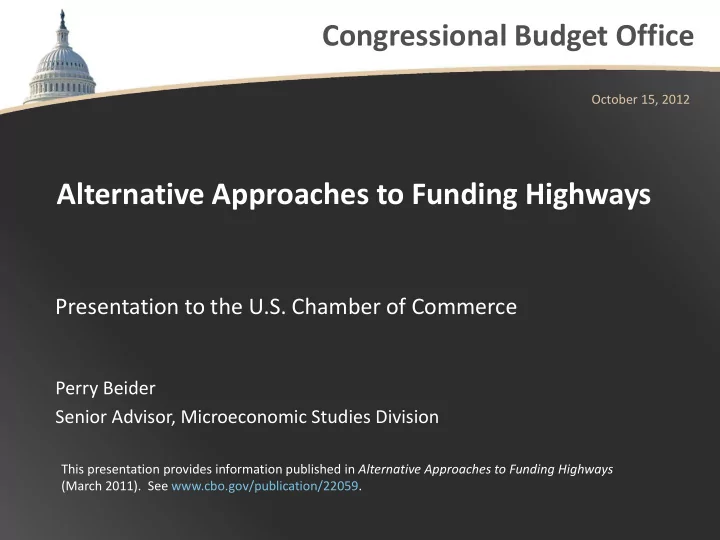

Congressional Budget Office October 15, 2012 Alternative Approaches to Funding Highways Presentation to the U.S. Chamber of Commerce Perry Beider Senior Advisor, Microeconomic Studies Division This presentation provides information published in Alternative Approaches to Funding Highways (March 2011). See www.cbo.gov/publication/22059.
CBO’s Report on Funding Alternatives for Federal Spending on Highways ■ Focuses on fuel and VMT taxes ■ Uses facts and estimates from literature ■ Provides an economic framework ■ Requested by the Chairman of the Senate Budget Committee C O N G R E S S I O N A L B U D G E T O F F I C E
Highway Funding Goals ■ Efficiency ■ Equity ■ Privacy C O N G R E S S I O N A L B U D G E T O F F I C E
Goal 1: Efficiency Maximize benefits of road travel net of total costs, including Costs of building and maintaining roads • Costs of using roads • Costs of the funding system itself (direct or indirect) • C O N G R E S S I O N A L B U D G E T O F F I C E
Comparing Fuel and VMT Taxes: Incentives for Efficient Road Use ■ Prescription for efficiency: Charge people for the marginal cost of their use or consumption of a good or service C O N G R E S S I O N A L B U D G E T O F F I C E
Estimated Mileage- and Fuel-related Costs Mileage-Related Costs Rural Passenger Vehicles Fuel-Related Costs (Converted to cents per mile) Urban Passenger Vehicles Rural Trucks Urban Trucks 0 10 20 30 40 50 60 70 C O N G R E S S I O N A L B U D G E T O F F I C E
Charges That Maximize Efficiency of Road Use ■ Charge for both VMT and fuel use ■ Total charges 3 to 8 times higher than today ■ Full marginal-cost pricing on entire road network would yield ~ $500 billion per year, 3 times the current total construction and O&M spending (~ $160 billion per year) ■ Efficient VMT charge: uniform “base” component + (potentially much larger) “congestion” component that varies by time and place ■ Congestion charges could save ~$40 billion per year in construction, $20 to $50 billion per year in time and fuel C O N G R E S S I O N A L B U D G E T O F F I C E
Would Implementation Costs Outweigh the Benefits of VMT Taxes? ■ Costs of a nationwide system very uncertain; available evidence is limited ■ Estimated benefits of $60 to 90 billion per year from congestion pricing leave a lot of room for implementation costs ■ What about less comprehensive VMT taxes? C O N G R E S S I O N A L B U D G E T O F F I C E
Goal 2: Equity Fair treatment for • Different groups of users? • General taxpayers? • People with low incomes? • Rural residents? • “Donor” states? • All of the above? C O N G R E S S I O N A L B U D G E T O F F I C E
Equity Implications ■ Both fuel and VMT taxes satisfy “user pays” criterion ■ Both fuel taxes and VMT taxes other than congestion charges impose larger relative burdens on • Households that drive more (e.g., rural) • Lower-income households ■ Fuel taxes also impose larger relative burdens on households using lower-MPG vehicles (sports cars, SUVs, pickup trucks, old cars) ■ Congestion charges shift tax burden toward (mostly urban) households that drive in congested conditions C O N G R E S S I O N A L B U D G E T O F F I C E
Goal 3: Privacy ■ Implications for efficiency and equity ■ But core issue is respecting individuals’ rights C O N G R E S S I O N A L B U D G E T O F F I C E
Options for Addressing Privacy Concerns 1. Limit the information used 2. Use detailed information but do all charge calculations in- vehicle • Store info internally for specified time or • Deduct charges in real time from prepaid debit card 3. Use detailed info; calculate charges externally but • Anonymously or • Using a private company 4. Ease into VMT system; let private firms bundle other services 5. Allow “safety valve” opt-out alternative(s) for those most concerned about privacy C O N G R E S S I O N A L B U D G E T O F F I C E
Summary Comparisons Compared to fuel taxes, VMT taxes • Provide better incentives for efficient road use • Are no worse on some interpretations of equity and better on others • Have higher (and more uncertain) implementation costs • Raise privacy concerns (for congestion charges) C O N G R E S S I O N A L B U D G E T O F F I C E
Two Key Questions for a System of VMT Charges ■ What should the system do? • Just raise revenue? • Reduce pavement damage? • Reduce specific congestion problems? • Maximize efficiency of road use? ■ Who should lead the system’s introduction? • The federal government? • The states? • The private sector? C O N G R E S S I O N A L B U D G E T O F F I C E
Recommend
More recommend